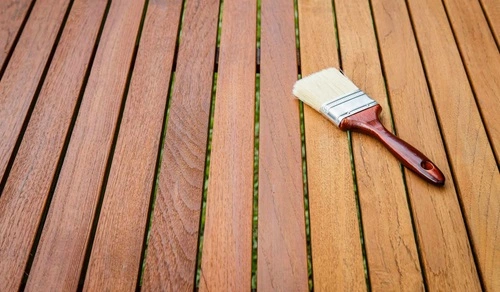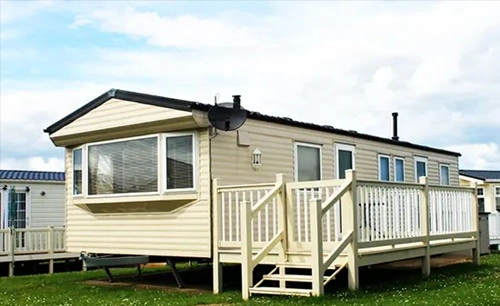A freshly painted deck might seem like a great way to enhance your outdoor space, but experts warn that it could do more harm than good. While paint may initially improve a deck’s appearance, it often leads to cracking, peeling, moisture retention, and costly repairs over time.
For homeowners considering painting their decks, it’s crucial to understand why paint is not the best option for outdoor wooden surfaces. In this article, we explore the reasons why you should never paint a deck, alternative ways to protect your deck, and the latest expert recommendations for long-term deck maintenance.
1. Paint Traps Moisture, Leading to Rot and Decay

One of the biggest reasons not to paint a deck is that it traps moisture inside the wood, accelerating rot and decay.
- Wood needs to breathe: Unlike siding or indoor flooring, deck boards expand and contract with changing temperatures and humidity levels.
- Paint creates a moisture barrier, preventing proper airflow and causing wood to retain water.
- Rot spreads quickly, leading to weakened boards, structural instability, and costly repairs.
According to a 2023 Home Improvement Report by the National Association of Home Builders (NAHB), improperly painted decks experience 40% more rot-related issues than stained or sealed decks.
2. Paint Peels and Chips Quickly
While paint may look great when first applied, it is not designed to withstand foot traffic, weather changes, and UV exposure.
- Sun exposure causes fading and cracking, leading to an uneven, worn-out appearance.
- Paint peels under foot traffic, especially in areas with heavy use, such as stairs and entry points.
- Once paint starts peeling, it becomes nearly impossible to touch up without stripping and repainting the entire deck.
The average painted deck requires a full repaint every 1-2 years, whereas properly sealed or stained decks last 3-5 years before maintenance is needed.
3. Painting a Deck Increases Maintenance Costs
Homeowners who paint their decks often find themselves trapped in an expensive maintenance cycle.
- Frequent scraping, sanding, and repainting are needed to keep the deck looking fresh.
- Once paint starts to peel, a complete removal is required before repainting, which is labor-intensive and costly.
- Power washing and chemical stripping are often necessary before a new coat of paint can be applied.
In contrast, staining or sealing a deck requires less frequent upkeep, saving homeowners time and money.
4. Painted Decks Become Slippery and Unsafe
Unlike stains and sealers that enhance the natural texture of wood, paint creates a smooth, slick surface that can become extremely slippery when wet.
- Painted decks increase the risk of slips and falls, especially in rainy or icy conditions.
- Darker paints absorb heat, making deck surfaces uncomfortably hot in the summer.
- Algae and mildew growth are more common on painted decks, further increasing slipperiness.
According to the Consumer Product Safety Commission (CPSC), falls from outdoor decks are one of the leading causes of home-related injuries in the U.S. Avoiding paint can help reduce this risk.
5. It’s Hard to Reverse a Painted Deck
One of the biggest regrets homeowners experience after painting a deck is how difficult it is to remove.
- Stripping paint from wood is time-consuming and expensive—often requiring chemical strippers, sanding, and power washing.
- Even after removing the paint, wood fibers may be permanently damaged, preventing the use of a stain or sealant in the future.
- Many homeowners find themselves stuck in a cycle of repainting, as removing paint completely is nearly impossible without professional help.
6. Paint Covers the Natural Beauty of Wood
One of the main reasons people choose wood decks over composite or concrete patios is for their natural beauty and grain patterns.
- Painting hides wood’s natural appearance, making it look more artificial.
- Wood stains and sealers enhance the wood’s natural grain, maintaining its rustic and organic appeal.
- If you later decide to sell your home, buyers may prefer a stained or sealed deck over a painted one, as natural wood surfaces are more desirable in real estate markets.
A 2023 Home Design Trends Report found that 72% of homeowners prefer stained or natural wood decks over painted ones, as they offer a warmer, more inviting aesthetic.
What Should You Do Instead of Painting?
Instead of painting, consider these better alternatives for protecting your deck:
✅ Staining: Stains penetrate the wood, enhancing its natural look while protecting it from moisture and UV damage. Stains come in transparent, semi-transparent, and solid options.
✅ Sealing: A clear sealant provides water and UV protection without altering the natural appearance of the wood.
✅ Deck Oil: Penetrating deck oils nourish the wood while offering water resistance and UV protection.
✅ Using Composite Decking: If you want a colored deck without maintenance, consider composite decking materials, which never need painting or staining.
FAQs About Painting a Deck
Q1: Can I paint my deck if it’s already painted?
Yes, but it requires thorough preparation. You’ll need to scrape off peeling paint, sand the surface, and apply a high-quality primer before repainting. However, switching to stain or sealant after painting is much harder.
Q2: What if I really want to add color to my deck?
Instead of painting, use a solid-color stain. It provides color while allowing the wood to breathe, reducing peeling and moisture issues.
Q3: Can I use exterior house paint on my deck?
No. House paint is designed for vertical surfaces like walls and does not hold up well to foot traffic and weather conditions. Always use a product specifically designed for decks.
Q4: How do I remove paint from my deck?
Removing paint requires chemical strippers, sanding, and power washing. It’s a labor-intensive process, and in some cases, replacing the boards may be the best option.
Q5: What’s the best way to make an old deck look new without painting?
- Power wash the surface to remove dirt and old stains.
- Use a high-quality stain or deck oil to enhance its natural beauty.
- Apply a sealant for long-lasting protection against moisture and UV damage.
Conclusion: The Final Verdict on Deck Painting
Painting a deck may seem like an easy way to refresh your outdoor space, but it comes with long-term problems that can be costly and time-consuming. From trapping moisture and peeling issues to increased maintenance and safety risks, painting is not the best option for deck preservation.
Instead, homeowners should opt for staining, sealing, or using composite materials, which provide better durability, lower maintenance, and enhanced natural beauty.
Before making a decision, consider this: Would you rather repaint every two years or have a deck that lasts beautifully for decades?.



